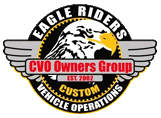Today, I rode away from Ed Dahir's dyno shop, The Dyno Difference, with an incredibly smooth and more rideable 2010 CVO Street Glide. Ed taught me an important lesson: A dyno is more than a tune. It's a diagnostic tool that can tell us alot about what's going on with our bikes.
The dyno tuning started on Friday when I took the bike to Ed's shop - a few weeks after Harley-Davidson of North Texas had installed Fullsac's X-Pipe (B), 2" core baffles and Steve George's TTS Mastertune fuel map. Ed was halfway into the dyno tune when he stopped, due to very high AFR readings on the rear cylinder. They were way out of sync with the AFRs on the front cylinder (which tuned just fine). Ed concluded that the high AFRs were probably due to a rear fuel injector problem, which resulted in the rear cylinder not getting enough fuel and running very hot (ouch! 2,400+ miles on the rear cylinder under abnormally high AFRs - no wonder the bike was going into engine idle temperature management mode so often). So, we called Harley-Davidson of North Texas and I made an appointment to get a new rear fuel injector installed on Saturday. North Texas Harley installed the injector late Saturday afternoon and had me back on the road in no time flat (thanks to their excellent service department and techs).
As it turned out, Ed was right on target with the fuel injector hypothesis. Today, Ed was able to complete the dyno tune because he made an accurate diagnosis of the rear cylinder's AFR data from his dyno system. The diagnostics changed everything. As a result, my bike runs cooler, smoother and has plenty of low-end torque.
Here is a summary of the HP / TQ results:
- Before the dyno tune: 89.1 HP @ 5246 RPM / 111.1 ft lbs TQ @ 3263 RPM (Fullsac X-Pipe (B), Fullsac 2" core baffles, SE Ventilator, SE 255 cams)
- After the dyno tune: 93.2 HP @5196 RPM / 114.6 ft lbs TQ @3097 (Fullsac X-Pipe (B), Fullsac 2" core baffles, SE Ventilator, SE255 cams)
The numbers don't tell the real story. Saving ther rear cylinder and the rideability of the bike do.
Thanks, Ed. You went over the top working on Sunday!!
Rick
 Author
Topic: The Dyno Difference (Read 4203 times)
Author
Topic: The Dyno Difference (Read 4203 times)

